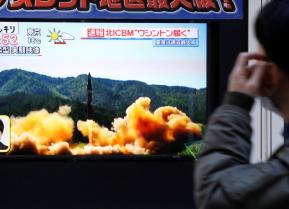Study This Picture: This Could Be the Army's New Future Infantry Fighting
Introducing the Lynx: an effort to combine German combat-vehicle engineering and expertise with Raytheon’s weaponry, sensor and computing technology.
“If no one has their screen turned to that view, threat-related information is not of use to the crew,” Schirmer said.
This kind of camera-sensor synergy, Schirmer explained, can be heavily fortified by AI which can quickly and simultaneously perform a wide range of functions - to reduce what developers call the “cognitive burden” upon the operators.
“AI reduces the amount of work to be done remotely and brings the crew’s attention to threats they might not otherwise see,” he added.
AI draws upon algorithms to function autonomously to test enemy defenses, travel at high speeds, perform advanced ISR functions and even fire weapons. In this kind of scenario, humans would of course operate in a role of command and control, allowing self-driving machines to confront the highest risks.
“The Lynx offers a manned-unmanned teaming opportunity. The vehicle has a digital backbone and fly-by-wire technology to move to optionally manned,” Hudson said.
Turret-launched attack drones are identified as a key component of emerging Army requirements for the NGCV for counter air, ISR and land-attack missions. Raytheon-Rheinmetall is offering a drone system called Coyote; small swarms of tube-launched Coyote drones fired from the Lynx turret are intended for ISR, electronic warfare and direct attack missions. Groups of small drones can blanket an area with surveillance, sending back combat-essential detail such as enemy force movements on the other side of a hill. Coyotes can also be used as expendable explosives or guided attack drones designed to hit non-line-of-sight targets.
Ernzen said Raytheon has been working with the Army on Coyote as a way to, among other things, introduce a counter drone weapon.
Finally, very little of this overall attack and survivability plan would fully come to fruition without advanced Active Protection Systems. These technologies, many of which are already operational, use computer-enabled fire-control, advanced radar and interceptor weapons to identify, track and destroy approaching enemy fire in a matter of seconds, or even milliseconds.
Along these lines, Schirmer has explained that advanced APS able to knock out kinetic-energy penetrator rods will need to emerge so that defenses are not only able to intercept RPGs and Anti-Tank Guided Missiles.
Threat levels are part of the reason many of the industry offerings are building “adjustable” vehicles. This includes building interchangeable turrets, configured with different weapons depending upon the mission, and adding sensors or attack drones as necessary. Air Defense is also a vital element of this, Schirmer said. Should the Army be operating in areas where there are enemy helicopters, overhead artillery, drones or aircraft threats, the vehicles will be equipped with interceptor attack drones or air-defense missiles such as Stingers or Hellfire missiles.
Interestingly, some of these areas of innovation may not be rest, ricted to just the NGCV, according Maj. Gen. Brian Cummings, Program Executive Officer, Ground Combat Systems.
“Right now we are trying to get the replacement for the Bradley to be the first optionally manned fighting vehicle. As we get that capability we may look at technology that we are getting in the future and insert them into current platforms,” Cummings told Warrior in an interview at AUSA in October.
Cummings also said Army developers are working on both near-term and longer term plans; he said it was entirely possible that a future tank or tank-like combat vehicle could emerge out of the NGCV program.
Russian Threat
While there are of course many reasons for the massive acceleration of the Army’s new infantry carrier, service developers are not hesitant to cite a Russian threat in Eastern Europe as part of the equation.
“According to the National Defense Strategy, we need to make sure we can provide a deterrent force to Eastern Europe. We have challenges in Eastern Europe,” Schirmer said. “Russia’s order of battle has incredible density of artillery pieces.”
At the same time, however, Schirmer did not indicate that the much-discussed new Russian tank, the technological advanced T-14, was a specific concern.
“All these new things are necessary without the T-14 on the battlefield,” he said.
Osborn previously served at the Pentagon as a Highly Qualified Expert with the Office of the Assistant Secretary of the Army - Acquisition, Logistics& Technology. Osborn has also worked as an anchor and on-air military specialist for National TV networks. He has a Masters degree in Comparative Literature from Columbia University.
This first appeared in Warrior Maven here.


